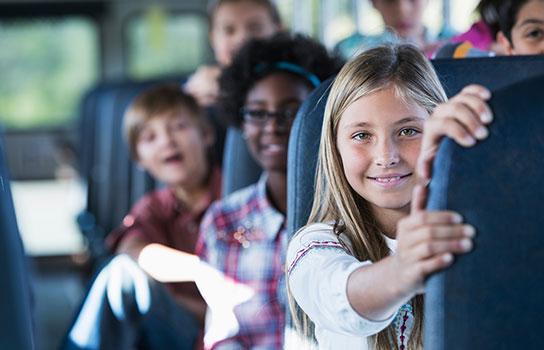
School Bus Safety
Stay safe on two wheels or four.Bike Safety Tips
Stats and Facts
- There are nearly 13,300 school buses driven in the state of Minnesota, transporting nearly 812,000 children each school day.
- Those buses drive more than 137 million miles in a school year.
- Children are 8x safer riding in a bus to school than any other vehicle.
- In Minnesota, failure to stop for a school bus with red flashing lights is a misdemeanor offense, with a possible fine of not less than $300 and a possible driver’s license suspension.
- From 2013-2017 there were 3,451 school bus crashes in Minnesota, resulting in only seven deaths.
The greatest risk students face comes not from riding the bus, but in approaching or leaving the bus. Before children go back to school or start school for the first time, it is essential that adults and children know traffic safety rules.
- When backing out of a driveway or leaving a garage, watch out for children walking or bicycling to school.
- When driving in neighborhoods with school zones, watch out for young people who may be thinking about getting to school, but may not be thinking of getting there safely.
- Slow down. Watch for children playing or congregating near bus stops, or walking in the street; especially if there are no sidewalks in the neighborhood.
- Be alert. Children arriving late for the bus may dart into the street without looking for traffic.
- Altering a route or schedule to avoid a bus route is one way motorists can help improve safety. By doing so, the motorist is less likely to put children at risk since they are no longer in the school path.
- Learn and obey the school bus laws in your state. Learn the “flashing signal light system” that school bus drivers use to alert motorists of pending actions:
- Yellow flashing lights indicate that the bus is preparing to stop to load or unload children. Motorists should slow down and prepare to stop their vehicles.
- Red flashing lights and extended stop arms indicate that the bus has stopped, and that children are getting on or off. Motorists must stop at least 20 feet from a school bus that is displaying red lights and/or its stop arm is extended when approaching from the rear and from the opposite direction on undivided roads. If the road is divided, the motorists on the opposite side of the separated roadway (median, etc.) are not required to stop, but should remain alert for children.
- Get to the bus stop at least five minutes before the bus is scheduled to arrive.
- When the bus approaches, stand at least three giant steps (6 feet) away from the curb, and line up away from the street.
- Wait until the bus stops, the door opens, and the driver says that it’s okay before stepping onto the bus.
- If you have to cross the street in front of the bus, walk on the sidewalk or along the side of the road to a point at least five giant steps (10 feet) ahead of the bus before you cross. Be sure that the bus driver can see you, and you can see the bus driver.
- Use the handrails to avoid falls. When exiting the bus, be careful that clothing with drawstrings and book bags with straps don’t get caught in the handrails or doors.
- Never walk behind the bus.
- Walk at least three giant steps away from the side of the bus.
- If you drop something near the bus, tell the bus driver. Never try to pick it up because the driver may not be able to see you.
- Never run into or play in the street at the bus stop or on your way to school.
We all must do our part to ensure that school buses remain one of the safest forms of transportation for our children. You can help by teaching your children to follow these practices to make school bus transportation safer.
- When a school bus is stopped with its red lights flashing and its stop-arm extended, you must stop your vehicle at least 20 feet from the bus. This is true whether you are behind the bus or in the opposite lane on an undivided road. You may not move your vehicle until the stop-arm is retracted and the red lights are no longer flashing.
- If your children wait in the car for the bus to come, help them check and make sure there are safe before exiting the vehicle to head to the bus.
- If possible, have a parent or guardian at the bus stop to help ensure the children are safe and not playing in the street. If there are multiple families that share your bus stop, you can rotate who is the chaperone.
- If you leave shortly after the bus, make sure you are watching for any children that missed the bus, or have yet to be picked up.
